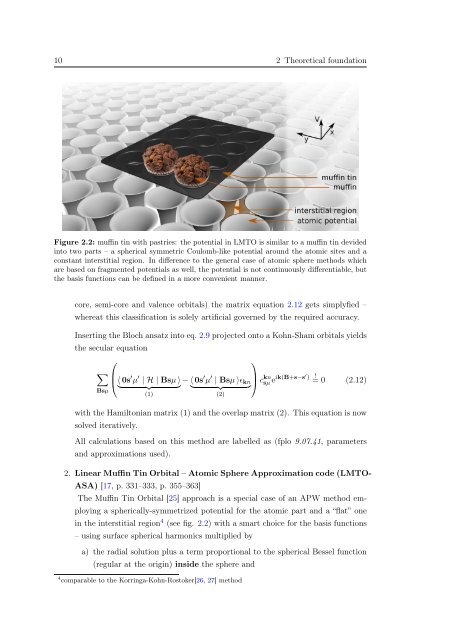Diploma - Max Planck Institute for Solid State Research
Diploma - Max Planck Institute for Solid State Research
Diploma - Max Planck Institute for Solid State Research
Create successful ePaper yourself
Turn your PDF publications into a flip-book with our unique Google optimized e-Paper software.
10 2 Theoretical foundation<br />
Figure 2.2: muffin tin with pastries: the potential in LMTO is similar to a muffin tin devided<br />
into two parts – a spherical symmetric Coulomb-like potential around the atomic sites and a<br />
constant interstitial region. In difference to the general case of atomic sphere methods which<br />
are based on fragmented potentials as well, the potential is not continuously differentiable, but<br />
the basis functions can be defined in a more convenient manner.<br />
core, semi-core and valence orbitals) the matrix equation 2.12 gets simplyfied –<br />
whereat this classification is solely artificial governed by the required accuracy.<br />
Inserting the Bloch ansatz into eq. 2.9 projected onto a Kohn-Sham orbitals yields<br />
the secular equation<br />
⎛<br />
⎞<br />
∑<br />
⎜<br />
⎝〈 0s ′ µ ′ | H | Bsµ 〉 − 〈 0s ′ µ ′ ⎟<br />
| Bsµ 〉ɛ<br />
} {{ } } {{ kn ⎠ c kn<br />
}<br />
Bsµ<br />
(1)<br />
(2)<br />
sµ e ik(B+s−s′ ) !<br />
= 0 (2.12)<br />
with the Hamiltonian matrix (1) and the overlap matrix (2). This equation is now<br />
solved iteratively.<br />
All calculations based on this method are labelled as (fplo 9.07.41, parameters<br />
and approximations used).<br />
2. Linear Muffin Tin Orbital – Atomic Sphere Approximation code (LMTO-<br />
ASA) [17, p. 331–333, p. 355–363]<br />
The Muffin Tin Orbital [25] approach is a special case of an APW method employing<br />
a spherically-symmetrized potential <strong>for</strong> the atomic part and a “flat” one<br />
in the interstitial region 4 (see fig. 2.2) with a smart choice <strong>for</strong> the basis functions<br />
– using surface spherical harmonics multiplied by<br />
a) the radial solution plus a term proportional to the spherical Bessel function<br />
(regular at the origin) inside the sphere and<br />
4 comparable to the Korringa-Kohn-Rostoker[26, 27] method
















